
- Homepage
- Brand
- Material
- Model
- Adidas Crazy Byw (4)
- Adidas Forum 84 (3)
- Air Jordan 1 (20)
- Air Jordan Retro (7)
- Casio G-shock (17)
- Grill (3)
- Imperial (12)
- Jordan 1 (8)
- Jordan Air Jordan 1 (3)
- Jordan Og (3)
- Nike Air Force 1 (8)
- Nike Air Jordan 1 (5)
- Nike Air Max 1 (9)
- Nike Air Max 2012 (3)
- Nike Air Max 90 (5)
- Nike Sb Dunk Low (4)
- Ribbon (6)
- Royal Mesh (6)
- Royal Starship (3)
- Royale (27)
- ... (2557)
- Scale
- Vehicle Make
- Vehicle Type
Ultra Rare WW1 Imperial Russian Army Gimnasterka M1916 Summer Tunic (New)










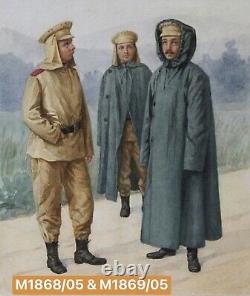

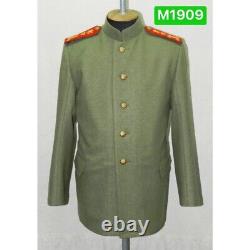

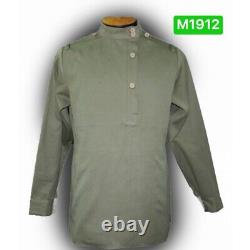
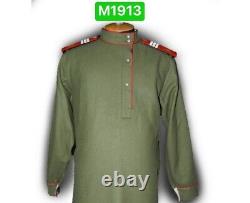
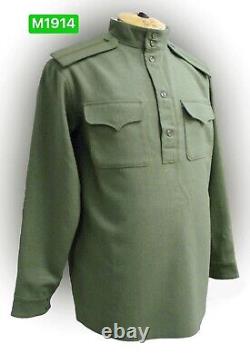


Ultra Rare WW1 Imperial Russian Army Gimnasterka M1916 Summer Tunic (New). Historical story of Gymnastyorka (English: Gimnasterka). The iconic field combat service shirt "Gimnasterka" are base on Russian traditional shirt "Kosovorotka" the idea was from since official military combat & peace service uniforms were normally made by wool or thick fabric, so the hot climate conditions are impacting for the troops in some southern regions (Turkestan for best examples). In late 1840s and early 1850s Ministry of War No. 2238 Dated May 7, 1856 provided a white linen sailor shirt without shoulder straps as summer uniforms for cadets in military schools, this earliest type of tunic are name as "Gimnasterka" which mean gymnastic shirt that because it were designed to use for sports & working uniform not a combat uniform.
Later Turkestan Military District of the Russian Empire began to used "Gymnastyorka" shirt that made from bleached linen as field combat service uniform unofficially in mid 1860s. By order of the Military Department No.
14 of 1866, a linen shirt and trousers were introduced for the lower ranks as working uniforms. In order to receive this shirt & trousers, it need to be from prescribed expense by the regimental funds for soldiers.392 of 1868, it was allowed to wear shoulder straps on linen M1868 "Gimnasterka" shirts. Order of the Military Department No. 149 of April 26, 1869. "Gimnasterka" shirts were officially accepted as field combat service summer uniform and began to supply this type of shirt to all lower ranks soldiers in the Turkestan Military District of Russian Empire.
Know as M1869 "Gimnasterka" which are made from bleached linen meanwhile M1868 are unbleached linen that made it color more on grey tone than white. In 1870, by order of the Military Department No.
383, this M1869 "Gimmnasterka" shirt, category as working shirt, it was assigned to medical units for lower ranks soldiers. Later, the "Gimnasterka" shirts used as working and summer uniforms were assigned to the lower ranks of artillery, transport, as well as sapper units.
58 dated April 1, 1877, all soldiers and officers of the active army allowed to prepares & use M1868 & M1869 "Gimnasterka" shirts as another option for combat uniforms for future war with Ottoman Empire (11 days later Russian Empire declared war against Ottoman Empire on date April 12, 1877). At the end of the Russo-Turkish war, "Gimnasterka" shirts continue to used widely by both Regular Army and Imperial Guard, along with a new form of uniforms adopted during Alexander III (several M1881 combat & peace service uniforms). At the beginning of the 20th century, "Gimnasterka" shirts become the main field uniform of the Russian army. In 1904 Empire of Japan declared war on Russian Empire, many Russian garrisons were already equipped themselves with M1868 & M1869 "Gimnasterka" shirts in Russia far east & Russian Manchuria regions, 1 year after fighting brutally against Japanese, Imperial Russian Army experienced that wearing a blight white shirt as field combat uniform open field in summer on Manchuria fronts are not a great idea anymore.Since it provides a easier to identify and be spotted by Japanese troops than using M1881 black or dark blue wool uniforms (at least it had a better camouflaged with Manchuria battlefield ground than blight white shirt). Many soldiers included officers now dye their white M1868 & M1869 "Gimnasterka" shirt into Khaki (Dirt, Brown, Green Pea colors) to camouflage them.
Those became M1868/1905 & M1869/1905 "Gimnasterka" shirts. Some NCO & Officer even order a special "Gimnasterka" that features 1 or 2 chest pockets and most importantly a new unofficial "Khaki" color in order to save themselves on field more than previous troops in 1904, before sent to frontline on far east Russia.
After Russo-Japanese War end and Russia find themselves that they're defeat on this war. One of military reforms plan was given a birth to new pattern of "Gimnasterka" field combat service shirt in 1907 (that included 2 lower waist pockets, new green pea khaki color and made from wool but also had another version of M907 experiment with tent fabric for water proof & stronger materials than wool, cotton, linen) for lowering rank & NCO of Imperial Russian Army. Later in 1909, 1911, 1912, and 1913 newer models that reduced complexity and time also production costs of the 1907 model that mainly for Privates & NCO ranks. M1909 are base on new M1907 Officer tunic (hard standing collar with 4 pockets and green pea khaki) but remove 2 chest pockets and for Privates & NCO ranks. M1911 are "Gimnasterka" M1907 shirt but remove 2 lower pockets and move buttoned placket line to more on left side (for wearer point of view) and made from wool fabric which made for winter. M1912 are "Gimnasterka" M1911 but made from cotton for summer. Another version had 2 chest pockets on shirt as well. M1913 are M1911 but collar, buttoned placket, and cuff were lined with colored piping sewn. (Piping sewn color are depends on regiment or branch of service uniform colors). This type of shirt considers as parade uniform. M1914 are official "Gimnasterka" model for officer made from wool or finest cotton and featured with 2 chest pockets (sometimes with pockets button). After Imperial Russian Army deployed new M1907 "Gimnasterka" marked it official ended glory era of M1868 & M1869 "Gimnasterka" shirts that base on late 1840s or early 1850s designs now became a obsoleted field combat service shirts uniform for ground forces of the Russian Empire. In 1907 Main Quartermaster Directorate of the Imperial Russian Army decided to try experimental of new type of army field combat service shirt that made from tent fabric. After introduced a new tent fabric peaked cap for lower rank soldier in 1915, it proofed in field that the tent fabric are more stronger & way more water proof than cotton and more suitable as uniform for fighting in trench warfare. This new stronger material uniform are helping a many struggling Russian soldiers in life trench in way better than before also improving combat readiness and capabilities of Imperial Russian Army for near future of largest and bloodiest of Imperial Russian military offensive during World War I known as "Brusilov offensive".
